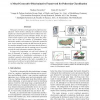Free Online Productivity Tools
i2Speak
i2Symbol
i2OCR
iTex2Img
iWeb2Print
iWeb2Shot
i2Type
iPdf2Split
iPdf2Merge
i2Bopomofo
i2Arabic
i2Style
i2Image
i2PDF
iLatex2Rtf
Sci2ools
112
Voted
CVPR
2008
IEEE
2008
IEEE
A mixed generative-discriminative framework for pedestrian classification
This paper presents a novel approach to pedestrian classification which involves utilizing the synthesized virtual samples of a learned generative model to enhance the classification performance of a discriminative model. Our generative model captures prior knowledge about the pedestrian class in terms of a number of probabilistic shape and texture models, each attuned to a particular pedestrian pose. Active learning provides the link between the generative and discriminative model, in the sense that the former is selectively sampled such that the training process is guided towards the most informative samples of the latter. In large-scale experiments on real-world datasets of tens of thousands of samples, we demonstrate a significant improvement in classification performance of the combined generative-discriminative approach over the discriminative-only approach (the latter exemplified by a neural network with local receptive fields and a support vector machine using Haar wavelet fea...
Classification Performance | Computer Vision | CVPR 2008 | Discriminative Model | Generative Model Captures | Particular Pedestrian Pose | Pedestrian Classification |
| Added | 12 Oct 2009 |
| Updated | 12 Oct 2009 |
| Type | Conference |
| Year | 2008 |
| Where | CVPR |
| Authors | Markus Enzweiler, Dariu M. Gavrila |
Comments (0)

